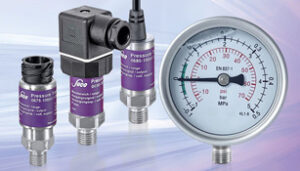 The compound pressure includes both a positive and a negative pressure range (vacuum) and thus enables a total pressure measurement across zero pressure.
The compound pressure includes both a positive and a negative pressure range (vacuum) and thus enables a total pressure measurement across zero pressure.
The reference point of a compound pressure transducer is set to ambient pressure. Its flexible diaphragm allows a linear output signal from vacuum (-1 bar / -14.7 PSI) through zero pressure to the full scale of the positive pressure. The measurement cell contains a hole that allows inherent compensation for atmospheric pressure changes.
Ex.: With an output signal of 4 – 20 mA, 4 mA corresponds to vacuum (-1 bar) and 20 mA corresponds to the positive scale pressure (e.g. 10 bar).
The effectiveness for measuring both vacuum and gauge pressure is limited to lower pressure ranges. Typically, they are used for pressure measurements from +1 to +16 bar (230 PSI) or less. Using a compound pressure transmitter for higher pressure ranges may have negative effects on the measuring accuracy in the vacuum range.
DNV GL approved pressure sensors offer distinct advantages and applications for ships, barges, offshore oil platforms and desalination. Having equipment that has been certified can reduce the risk of major incidents and can give piece of mind that failures will not be down to poor design of the equipment. It can be a requirement from Insurance companies and even some areas may restrict movement of vessels that do not have appropriate certification.
There are various levels of marine approval ranging from the very basic for use in cabins and locker spaces, through engine room and bilges, to on deck and even up mast mountings. These are classified by DNVGL as location classes and it is important that the equipment used is suitable and certified for use in each location, in relation to temperature, humidity, vibration, EMC, and enclosure. The location classes are defined on the equipment certificate, but further guidance can be found from DNVGL. ESI have aimed for the highest level in each class so that the products can be used in the most diverse range of applications on-board.
Temperature, humidity, vibration, enclosure and EMC classes define the different areas of location. Upon installation on board, it is to be ensured that each of the five location classes stated for the equipment in question meets the minimum location class required for the actual location.
Applications
Compound pressure transducers are predominantly used in systems where minimal pressure differences between overpressure and vacuum must be measured reliably. Among these are, for example, compressors (vapor recovery + gas compression), pumps (suction + discharge), leak tests of pipelines, test chambers in laboratories and general low-pressure applications.
Other typical applications of compound pressure transducers are building air climate controls and refrigeration equipment (HVAC/R). During normal operation, the transducer measures the positive pressure in the system. In the event of pending maintenance, it measures the negative pressure caused by suction when the system is evacuated.
Customized solutions
Our heavy-duty Compound pressure transmitters Hex22 are available in stainless steel grade 303 (1.4305) or grade 316L (1.4404). They have been specifically designed for use in demanding vacuum and oxygen applications, such as process manufacturing. The oil-filled measuring cell in stainless steel 316L enables high-precision pressure measurement of a wide variety of media within a broad temperature range.
Due to their above-average media compatibility and durability, our compound pressure transducers are used not only in industrial production but also in medical and chemical engineering. In addition to the standard compound pressure range of -1 to +1 bar (V01), other pressure ranges can be supplied on request.
